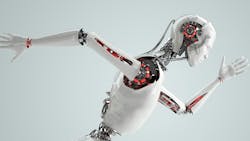This Liquid-Powered Robot System Was Inspired by Human Blood
A team of researchers from the University of Wisconsin–Madison has found a new way to power robots that could make them more sustainable, more life-like, and able to run longer. The work, led by James Pikul, an associate professor of mechanical engineering, was published on September 10, 2024, in the journal Matter. On top of the robotics breakthrough, the discovery could also be applied to other electromechanical systems and even chemical manufacturing.
Their approach is inspired by how the human body's circulatory system works: our body stores oxygen and glucose and sends them throughout to reach our cells to give us energy and nutrients.
Originally, in a project in 2019, James Pikul and his team of researchers created a synthetic vascular system for a "fishlike soft robot" that tripled the total time the fish could swim compared to using lithium-ion batteries. The liquid in this system was multifunctional, storing energy and serving as a hydraulic actuator that moved the mechanical components needed to swim.
Building off that 2019 project, the researchers have continued to perfect their liquid energy-storing system. To do that, they first revisited how traditional systems, like fuel cells, normally work. These setups rely on three ingredients working together in the same place at the same time: a gas (like oxygen), a liquid (to carry ions), and a source of electricity. But if there's too much liquid, the gas gets blocked and the reaction can't happen. If there's not enough liquid, the reaction fails for a different reason. The reaction also only happens at the surface where the gas and liquid meet, so there's a natural cap on how fast or how powerful it can be.
To get around this, the team came up with a clever fix: they mixed tiny silicone oil droplets into the liquid electrolyte. This type of silicone oil can hold six times more oxygen than water, which means now the entire liquid can take part in the reaction, not just the surface. That leads to faster chemical reactions, longer-lasting energy, and more power overall.
This idea is based on how hemoglobin works in our blood. Hemoglobin is a protein in red blood cells that binds to oxygen in the lungs and carries it throughout the body. It helps store and transport oxygen more efficiently than blood plasma alone. The team's new emulsion does something similar: it increases how much oxygen the liquid can store and use, just like hemoglobin does for our cells.
To create the right balance, the researchers were inspired by earlier attempts to make synthetic blood and liquid breathing solutions for deep-sea divers. Instead of using fluorinated compounds like in those older experiments, the team found that silicone oil worked better when blended with water. They discovered that a mix containing about 20% silicone oil gave them the best results: it stored more oxygen while still allowing ions to flow and power the system.
Compared to a standard electrolyte—the part of a battery that helps electricity move between components—the new emulsion produced faster reactions and delivered higher electrical currents. It’s a big step toward making energy systems that are more efficient and adaptable.
Looking ahead, the team wants to go even further by replacing the zinc anode (a key part of the battery) with a liquid version, creating a fully liquid-powered system from end to end.
"If we're going to continue to push the boundaries of science, we have to look at the intersection of different fields that we might not necessarily feel are super-related, and take inspiration from biology," says Alissa Johnson, the study's first author. "We make machines very differently from the way that humans or other animals work, and they've had years of evolution to perfect. So why shouldn’t we look at the circulatory system and say, 'Why can’t we make an energy source that's based off a continuous feed of materials rather than plugging something in and recharging it?'"
It's clear that blending biology with engineering can open new doors for robotics and beyond. With this discovery of how energy could be stored, robots could soon advance to something we haven't seen before. It's a reminder that sometimes the best solutions come from nature itself, inspiring the technology of tomorrow.
This isn't the first time researchers have turned to the human body or animals for robotic inspiration. Just a few weeks ago, I covered one of the most lifelike humanoid robots ever created, which uses synthetic muscles and bones to mimic human movement. Over the past decade, roboticists have drawn ideas from elephant trunks, geckos' sticky feet, and pangolins' ability to curl into a ball—each biological design offering their own unique capabilities. These biomimicry innovations are pushing the boundaries of what robots can do, making machines that move, adapt, and even "feel" in ways once thought impossible.
In this demonstration video, two of the Pikul lab's flow cells function as actuators, inflating and deflating, while also powering a connected LED light.
About the Author
Laura Davis
Editor-in-Chief, New Equipment Digest
Laura Davis is the editor in chief of New Equipment Digest (NED), a brand part of the Manufacturing Group at EndeavorB2B. NED covers all products, equipment, solutions, and technology related to the broad scope of manufacturing, from mops and buckets to robots and automation. Laura has been a manufacturing product writer for eight years, knowledgeable about the ins and outs of the industry, along with what readers are looking for when wanting to learn about the latest products on the market.
